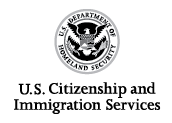Budget, Planning & Performance
Measuring and managing performance is essential to effective, efficient and economical delivery of services to the public. We work continuously to improve the quality of our measures to make them more meaningful and focused on those we serve.
Our mission and general information about us.
Budget and Performance
The Budget-in-Brief for Fiscal Year (FY) 2017 provides a brief account of the Department of Homeland Security, including USCIS funding and resources available to support our legislatively mandated mission. See the DHS Budget-in-Brief for FY 2017 (PDF, 3.20 MB) to view the report. Information about USCIS begins on page 119 of the document.
Strategic Plan 2017-2021
Our plan (PDF, 548 KB) aligns with the DHS Strategic Plan (PDF) to advance the unified vision of a homeland that is safe, secure and resilient against terrorism and other hazards. Our strategic goals are to:
- Identify, address, and mitigate national security and fraud risks to the immigration system;
- Deliver consistently high quality services;
- Enable our workforce to excel in a dynamic environment;
- Promote the importance, rights, and responsibilities of citizenship; and
- Enhance our interactions with those we serve, stakeholders, and the general public.
Funding
USCIS is funded primarily by immigration and naturalization benefit fees charged to applicants and petitioners. Fees collected from individuals or organizations filing immigration benefit requests are deposited into the Immigration Examinations Fee Account (IEFA). Congress created the IEFA in 1988, establishing the authority to recover the full cost of immigration benefit processing. This account represents approximately 95 percent of USCIS’ fiscal year (FY) 2016 total budget authority. The remaining budget authority comes from two other mandatory fee accounts and appropriated funding for the E-Verify program.
The Chief Financial Officers Act of 1990 requires that USCIS conduct biennial fee reviews for the IEFA. USCIS last adjusted its fees in November 2010. Results of the FY 2016/2017 fee review indicated that fees should be adjusted by a weighted average increase of 21 percent to ensure full cost recovery. These include the costs associated with fraud detection and national security; service and case processing; and providing services without charge to refugee and asylum applicants and to others for fee waivers or exemptions.
The new fees, including a reduced naturalization fee option for certain low income applicants, took effect on December 23, 2016. Here is a list of the changes. Filing fees increased for most forms, and we published updated versions of the forms at uscis.gov/forms. We strongly encourage applicants to download and submit these new versions, which are updated with the new fees and have an edition date of 12/23/16. We will accept prior versions of forms, with the exception of Form N-400, until February 21, 2017. However, all filings postmarked 12/23/16 or later must include the new fees or we will reject them.
The new fee schedule accounts for limited strategic investments, including targeted enhancements for refining and improving the delivery, security and integrity of the EB-5 visa program. The new fee schedule assumes no discretionary appropriations for Refugee, Asylum and International Operations; Systematic Alien Verification for Entitlements (SAVE); or the Office of Citizenship, including the Citizenship and Integration Grant program.
USCIS Fiscal Year 2016 Accomplishments
At USCIS, we measure success by how well we reinforce the country’s proud tradition as a nation of hope and opportunity, uphold the integrity of the immigration system, and safeguard our nation’s security. Our accomplishments at USCIS would not be possible without our exceptional workforce. The collective ingenuity, professionalism, and dedication of USCIS employees propel the agency to greater success year after year.
See the USCIS Fiscal Year 2016 Accomplishments page.







